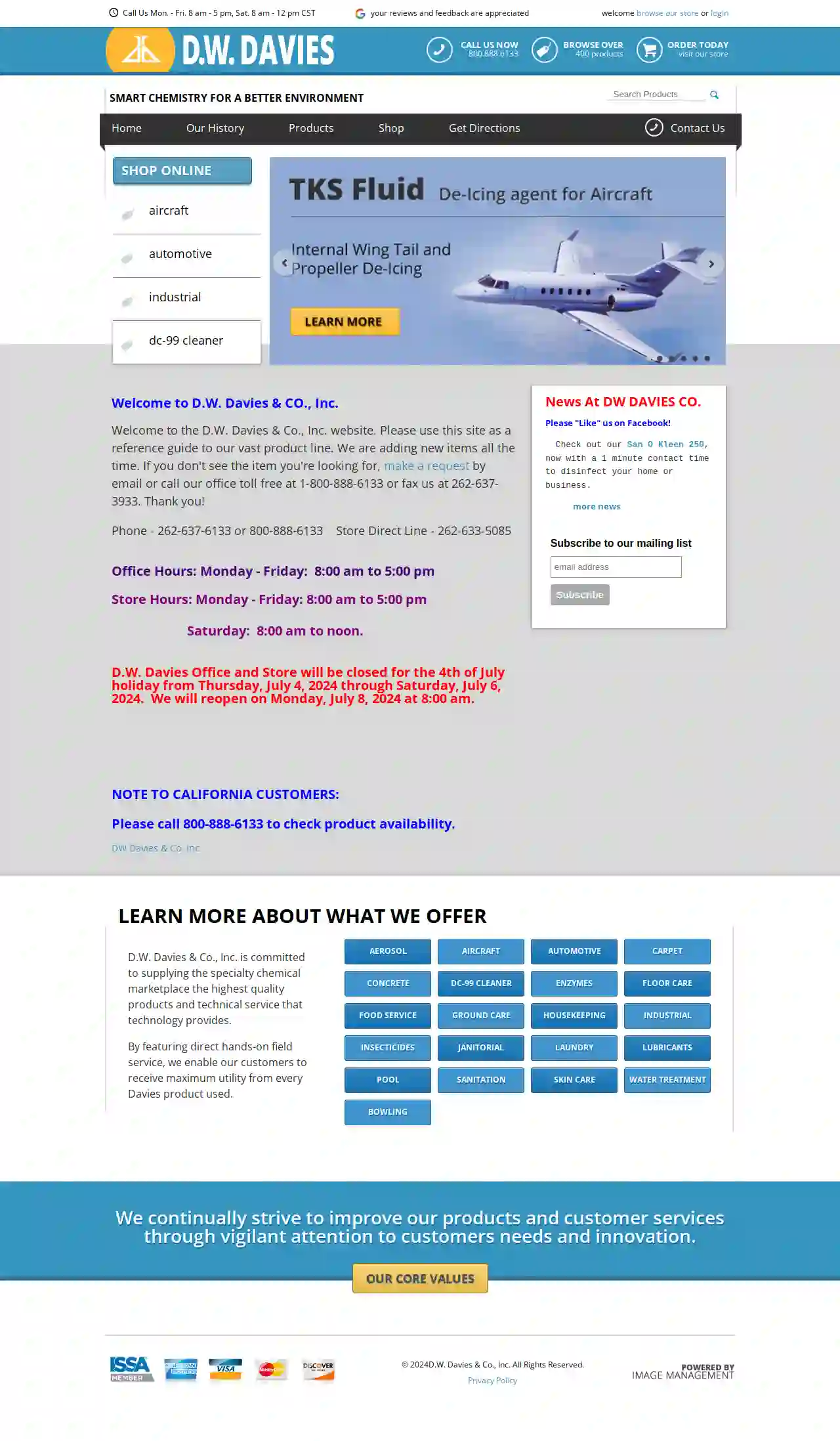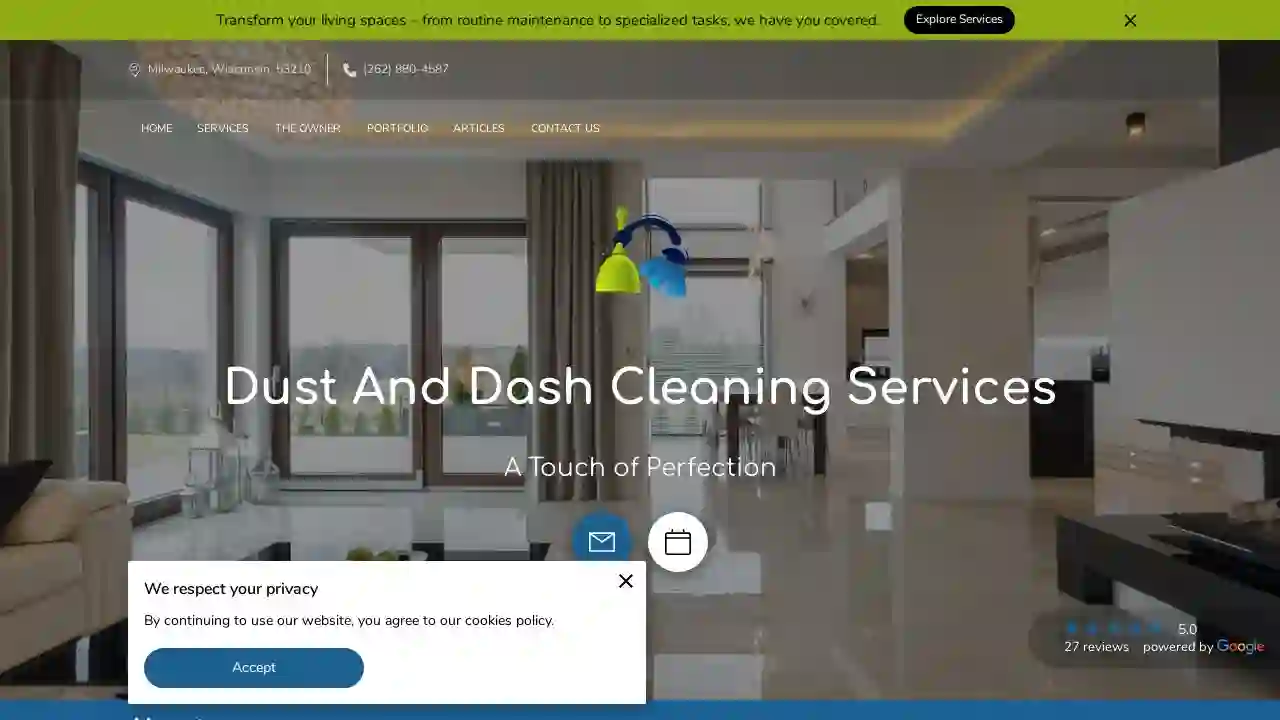Cleaning Services Prairie du Sac
Top 10 Home Cleaning in Prairie du Sac
Receive up to 3 Cleaning Companies quotes for your project today! Compare profiles, reviews, accreditations, portfolio, etc... and choose the best service.

Enviro-Master of Milwaukee
513 reviewsMilwaukee, US- Services
- Why Us?
- Gallery
Get Quote
Wisconsin Maid Cleaning Service LLC
53 reviewsPO BOX 2027, Eagle River, 54521, USAt Wisconsin Maid, we understand the importance of time and how it can slip away from us. That's why we're dedicated to providing top-notch cleaning services that give you back the time you deserve. Our team of skilled cleaners is passionate about delivering exceptional results, ensuring your home or business looks, smells, and feels fresher than ever before. Our story began with a vision to create a local house cleaning company that offers professional and safe services, without the need for a big franchise. We pride ourselves on building healthy relationships with our clients, taking the time to understand their needs and expectations. We treat every property we care for like it's our own, and that's why we say "we clean for family members, not customers". By choosing Wisconsin Maid, you'll get more than just a cleaning service. You'll get more time, freedom, and less stress. Our team is dedicated to providing you with a seamless online experience, making it easier for you to get your home or business cleaned. Try us and see what we're "maid" of!
- Services
- Why Us?
- Accreditations
- Our Team
- Testimonials
- Gallery
Get Quote
D.W. Davies & Co., Inc.
4.918 reviews12345 W. Capitol Drive, Brookfield, 53186, USD.W. Davies & Co., Inc. is a leading supplier of high-quality products and technical services to the specialty chemical marketplace. With a commitment to innovation and customer satisfaction, the company strives to continually improve its offerings and customer services. D.W. Davies & Co., Inc. is dedicated to providing the best possible solutions for its customers' needs.
- Services
- Why Us?
- Accreditations
- Our Team
- Testimonials
- Gallery
Get Quote
Jani-King
4.515 reviews123 Main St, Milwaukee, WI, 53201, USJani-King specializes in providing top-notch cleaning and janitorial services to various industries in Milwaukee, WI. With a focus on cutting-edge cleaning techniques, they ensure all cleaning needs are addressed efficiently. Their services include daily, weekly, and monthly cleaning packages tailored to meet the specific needs of different facilities.
- Services
- Why Us?
- Accreditations
- Our Team
- Testimonials
- Gallery
Get Quote
Quality Commercial Cleaning
51 reviews123 Main St, Springfield, 12345, USQuality Commercial Cleaning is a dedicated cleaning service provider, offering a wide range of cleaning solutions tailored to meet the unique needs of businesses. With a strong commitment to quality, customer satisfaction, and environmental sustainability, Quality Commercial Cleaning strives to provide top-notch cleaning services that enhance the appearance and functionality of commercial spaces. Our team of experienced professionals is equipped with the latest cleaning technologies and eco-friendly products, ensuring a clean, safe, and healthy environment for your employees and customers. From daily maintenance to deep cleaning, we have the expertise and resources to handle all your cleaning needs efficiently and effectively.
- Services
- Why Us?
- Accreditations
- Our Team
- Testimonials
Get Quote
BSG Maintenance Inc
3.323 reviewsMilwaukee, US- Services
- Why Us?
- Gallery
Get Quote
Cavallero Cleaning Service LLC
522 reviewsMilwaukee, US- Services
- Why Us?
- Gallery
Get Quote
Dust And Dash Cleaning Services
523 reviewsMilwaukee, US- Services
- Why Us?
- Gallery
Get Quote
T&M Cleaning Services Inc.
4.371 reviews5436 W Rogers St., West Allis, 53219, USAn important message from the T & M Cleaning Services company. SAFETY POLICY X × To Our Loyal Customers - As the COVID-19 situation evolves, T & M Cleaning Services is committed to reducing all possible risk to customers while continuing to provide the essential cleaning services you depend on. Our team are stringently following CDC recommendations regarding surface disinfecting and personal health guidelines to keep our clients as safe as possible. Read Our Statement Cleaning Services > Home Cleaning > Apartment Cleaning > Office Cleaning > Move In, Move Out > Garage, Attic, Basement > Regular Cleanings > Auto Detailing > Cleaning Prices About > Practice Facility Gallery FAQs Terms of Service Schedule Cleaning Jobs Contact - Where Relationship is 1st & Business is 2nd - House Cleaning 414-933-2785 Car Detailing 414-545-6430 Studio ApartmentsSmall BusinessesDream HomesRetirement Condos Home &OfficeCleaning AutoDetailing Milwaukee CO.SE WisconsinWaukesha CO. Cleaning Information Cleaning Tips Frequently Asked Questions Cleaning Gallery House Cleaning in Milwaukee, Waukesha & Southeast Wisconsin Southeast Wisconsin’s Premier Housekeeping Service Housekeeping is considered an essential business. We will be operating in full force to disinfect your home. We are taking extreme measures to ensure that our workers remain healthy. See our COVID-19 statement here. "Highly recommended for home cleaning and auto detail...I get my home cleaned every 4 weeks and they do an excellent job! It’s such a relief to come home to a clean house after a long day of work. From the folded towels in the bathroom to the vacuum lines in the carpet they are always thorough. I also have gotten both of my cars detailed and experienced the same level of care! I haven’t found a company comparable for my at-home needs! Thanks T&M!" - Monica T&M Cleaning Services Inc. is a family-owned cleaning service company. We have been providing the greater Milwaukee area with superior cleaning services since 1986. Our professional cleaning staff is highly trained in all aspects of home and office cleaning, using high-quality cleaning supplies. Each member of our cleaning team gets a chance to practice in our training facilities, perfecting our proven techniques. T&M Cleaning Services is dedicated to customer service and satisfaction, consistently providing our clients with an immaculately clean home or business. By utilizing our housekeeping services, you’ll have extra time to pursue the more important things in your life. Go on a family outing, relax and read a book, catch up on extra work for the office or just relax and have some time to yourself. All this and more can be yours by simply letting someone else handle the of cleaning your home. Our cleaning team eliminates dust and cobwebs, vacuums all your carpets, and mops your floor. You won’t have to lift a finger, allowing you to clear your schedule for more important things. Our first-time deep clean gets your home looking good as new, and regularly scheduled cleanings then on keep it clean year-round. Schedule your cleanings weekly, bi-weekly, or every 4 weeks—with no contractual agreement! Rely on T&M Cleaning Services Inc. to take care of all your house cleaning needs. Contact the Milwaukee housekeepers at T&M Cleaning Services for a superior home cleaning today. No Contract Milwaukee Housekeeping Services Unlike most maid services in Milwaukee, T&M Cleaning Services doesn’t require clients to sign long-term cleaning contracts. Most of our business comes from referrals and 1st time cleaning jobs that required deep cleaning. After an appointment is booked, the T&M professional cleaning staff arrives with their own equipment and cleaning supplies. The results speak for themselves; we earn the right to win back your repeat business. While we don’t require a contract, we certainly offer regularly scheduled cleanings. Get your home or office cleaned weekly, bi-weekly or once every 4 weeks to meet your needs. Professional Home Cleaning Services for Southeast Wisconsin To ensure we provide the best home cleaning services, T&M Cleaning requires each member of our staff has extensive practice cleaning various rooms in our training facilities. We have constructed a simulated home, fully furnished with: Kitchens Bathrooms Bedrooms Dining Rooms Living Rooms Home Offices We also have various countertop materials, fixtures, and flooring types, so each staff member has comprehensive cleaning knowledge and techniques. In addition to thorough training, each T&M cleaning crew is led by a cleaning specialist supervisor. These supervisors go through a rigorous 3 month training period. Upon completion, the cleaning specialists must pass four classes which include knowledge of the proper technique to clean bathrooms and kitchens, the best practices to use while dusting, and the safe use of our powerful cleaning chemicals. Trust in our experienced professionals, and rely on T&M to provide your home with comprehensive deep cleaning. Contact our housekeeping company for the best cleaning services in Milwaukee. Commercial Cleaning Services for Milwaukee Area Offices Our professional office cleaners serve small businesses in and near Milwaukee, including office buildings, dental offices, dermatology clinics, and other commercial spaces. Keep your business looking tidy, professional, and welcoming by scheduling office cleanings weekly, bi-weekly, every four weeks, or occasionally as needed. Our team will dust, vacuum floors and furniture, clean bathrooms and kitchen areas, and more. Unlike other Milwaukee commercial cleaning companies, T&M Cleaning Services offers flexibility instead of forcing you into a long-term cleaning contract. Whether you need office cleaning every week or just one time, contact us for the best housekeeping services in Southeast Wisconsin. Move-In/Move-Out Cleaning Business in West Allis When you’re packing up and moving, the last thing you want to do is spend hours cleaning your old home and your new one. It’s easy to stress out about too much clutter or mess – don’t let it get too overwhelming. T&M Cleaning Services can help you make the moving process a little easier. Whether you’re moving into or out of an apartment, a newly built house, or a foreclosure, our team of West Allis move-in, move-out cleaners will vacuum, clean kitchens and bathrooms, wash woodwork and light fixtures in order to ensure your move goes smoothly. Schedule your move-in, move-out cleaning job with T&M Cleaning today. We Clean Out Basements, Attics & Garages! Most of us have a tendency to neglect the state of our basements, attics, and garages—after all, our guests generally don’t see those areas. Storage bins and cardboard boxes pile up, cobwebs form and the job of cleaning the area can become a bit overwhelming. When it comes time for you to finally bite the bullet and clean out your basement, attic, or garage, you can call the professionals at T&M Cleaning to help you out! Our basement, attic, and garage cleaners will reorganize your possessions in storage and give the area a thorough cleaning, ensuring everything will be tidy and clutter-free. Give us a call today to schedule your cleaning. Windows and Storm Screen Cleaning in Milwaukee Keeping your home or commercial business’s windows clean and smudge-free on a regular basis can be difficult. When you don’t have the time to regularly wash your windows or storm screens, the professionals at T&M Cleaning Services can help you out. Get rid of all the smudges, dust and streaks on your windows with our window-washing service. We take care of it all – your window glass, storm screens and window wells will have never looked cleaner. Call us today and schedule your window and storm screen cleaning service. Milwaukee Car Detailing In addition to home and business cleaning services, T&M also provides auto detailing services for nearly any car, truck or SUV. Choose from a variety of services: Full Detail – interior and exterior detailing and uber-proficient finishing services Interior Detail – Shampoo upholstery and carpets, condition leather, cleaning the entire dash and a basic exterior hand washing Exterior Detail – Trim, tires and metal is polished and dressed, wax and seal on the paint and a basic interior wipe down and vacuum We also offer a variety of add-on car detailing package services. From tree sap and scratch removal to deodorizing your vehicle, T&M’s auto detailing specialists will have your vehicle looking showroom ready. Schedule a car detailing appointment with Milwaukee’s best cleaning service. Superior Milwaukee Housekeeping Services From regular weekly cleanings to one time deep cleanings, T&M Cleaning Services is the answer you’ve been looking for. We do it all, from thoroughly cleaning cubicles and offices in a business to dusting blinds and clearing cobwebs in your home. We pride ourselves on friendly, professional service at affordable rates. Let our highly experienced team of housekeepers provide your family with a sparkling home. Schedule your Milwaukee house cleaning services with T&M Cleaning Services today. Contact UsWith all your cleaning questions Services Auto Detailing Best in Wisconsin Schedule Cleaning Contact About Gallery Jobs Leave a Review FAQ Tips Terms of Service T&M Cleaning Inc. 5436 W Rogers St., West Allis, WI USA 53219 House Cleaning414-933-2785 Car detailing414-545-6430 Milwaukee County Bayside Bay View Brown Deer Cudahy Downtown Fox Point Franklin Glendale Greendale Greenfield Hales Corners Oak Creek River Hills Shorewood South Milwaukee St. Francis Wauwatosa West Allis Whitefish Bay Waukesha County Brookfield Butler Delafield Elm Grove Hartford Hartland Lisbon Men. Falls Muskego Mukwonago New Berlin Oconomowoc Pewaukee Sussex Vernon Waukesha SE Wisconsin Caledonia Cedarburg Germantown Lannon Mequon Wind Lake Racine © Copyright 2024 T&M Cleaning Services. All Rights Reserved To view this site properly, please enable JavaScript
- Services
- Why Us?
- Accreditations
- Our Team
- Testimonials
- Gallery
Get Quote
Diversified Cleaning Systems
4.52 reviewsGreen Bay, US- Services
- Why Us?
Get Quote
Over 60,241+ Cleaning Services on our directory
Our janitorial services operate in Prairie du Sac & beyond!
CleaningMatch has curated and vetted Top Cleaning Businesses near Prairie du Sac. Find a reliable contractor today.
Frequently Asked Questions About Cleaning Services
- Regular Sweeping or Dust Mopping: Sweep or dust mop hardwood floors daily to remove dust, dirt, and debris.
- Vacuuming: Vacuum hardwood floors weekly using a vacuum cleaner with a hardwood floor attachment to avoid scratches.
- Damp Mopping: Damp mop hardwood floors with a hardwood floor cleaner as needed. Avoid excessive water, as it can damage the wood.
- Prevent Scratches: Place felt pads under furniture legs to prevent scratches. Avoid dragging heavy objects across the floor.
- Avoid Harsh Cleaners: Do not use harsh chemicals, abrasive cleaners, or furniture polish on hardwood floors.
- Professional Cleaning: Consider hiring a professional hardwood floor cleaning service for deep cleaning and refinishing as needed.
- Using the wrong cleaning products: Certain cleaning products are unsuitable for specific surfaces. Using abrasive cleaners on delicate surfaces can cause scratches or discoloration.
- Not reading product instructions: Always read and follow the instructions on cleaning products to ensure proper usage and avoid potential hazards.
- Using dirty cleaning tools: Dirty cloths, sponges, and mops can spread germs and dirt instead of cleaning them. Rinse and sanitize your cleaning tools regularly.
- Skipping ventilation: Proper ventilation is essential when using cleaning products, especially those with strong fumes. Open windows and doors to allow fresh air circulation.
- Not allowing sufficient drying time: After cleaning, allow surfaces to dry completely to prevent mold and mildew growth, particularly in humid areas like bathrooms.
- Ignoring clutter: Clutter makes cleaning more difficult and time-consuming. Declutter regularly to maintain a cleaner and more organized home.
- Prepare the Windows: Remove dust and debris from windows using a brush, vacuum, or damp cloth.
- Cleaning Solution: Use a commercial glass cleaner or a homemade solution of equal parts water and vinegar.
- Spray and Wipe: Spray the cleaning solution onto the window, ensuring even coverage.
- Squeegee Technique: Use a squeegee to wipe the cleaner from top to bottom, overlapping each stroke by about an inch. Wipe the squeegee blade clean after each stroke.
- Dry Edges: Wipe the edges of the window with a clean, dry microfiber cloth to remove any remaining moisture.
- Residential Cleaning: Covers cleaning homes, apartments, and other living spaces.
- Commercial Cleaning: Focuses on cleaning offices, retail stores, and other business establishments.
- Deep Cleaning: A thorough and intensive cleaning that covers areas often neglected during regular cleaning.
- Move-In/Move-Out Cleaning: Comprehensive cleaning performed before or after moving into or out of a property.
- Post-Construction Cleaning: Specialized cleaning after construction or renovation projects to remove debris and dust.
- Specialized Cleaning: Includes services like carpet cleaning, window cleaning, upholstery cleaning, and more.
What are some tips for cleaning hardwood floors?
By following these tips, you can keep your hardwood floors looking beautiful for years to come.
What are some common cleaning mistakes to avoid?
By avoiding these common cleaning mistakes, you can improve your cleaning efficiency and achieve better results.
What is the best way to clean windows without streaks?
For best results, clean windows on a cloudy day or in the shade to prevent the cleaning solution from drying too quickly and leaving streaks.
What are the different types of cleaning services?
The best type of cleaning service depends on your specific needs, the size and condition of the property, and your budget.
What are some tips for cleaning hardwood floors?
- Regular Sweeping or Dust Mopping: Sweep or dust mop hardwood floors daily to remove dust, dirt, and debris.
- Vacuuming: Vacuum hardwood floors weekly using a vacuum cleaner with a hardwood floor attachment to avoid scratches.
- Damp Mopping: Damp mop hardwood floors with a hardwood floor cleaner as needed. Avoid excessive water, as it can damage the wood.
- Prevent Scratches: Place felt pads under furniture legs to prevent scratches. Avoid dragging heavy objects across the floor.
- Avoid Harsh Cleaners: Do not use harsh chemicals, abrasive cleaners, or furniture polish on hardwood floors.
- Professional Cleaning: Consider hiring a professional hardwood floor cleaning service for deep cleaning and refinishing as needed.
By following these tips, you can keep your hardwood floors looking beautiful for years to come.
What are some common cleaning mistakes to avoid?
- Using the wrong cleaning products: Certain cleaning products are unsuitable for specific surfaces. Using abrasive cleaners on delicate surfaces can cause scratches or discoloration.
- Not reading product instructions: Always read and follow the instructions on cleaning products to ensure proper usage and avoid potential hazards.
- Using dirty cleaning tools: Dirty cloths, sponges, and mops can spread germs and dirt instead of cleaning them. Rinse and sanitize your cleaning tools regularly.
- Skipping ventilation: Proper ventilation is essential when using cleaning products, especially those with strong fumes. Open windows and doors to allow fresh air circulation.
- Not allowing sufficient drying time: After cleaning, allow surfaces to dry completely to prevent mold and mildew growth, particularly in humid areas like bathrooms.
- Ignoring clutter: Clutter makes cleaning more difficult and time-consuming. Declutter regularly to maintain a cleaner and more organized home.
By avoiding these common cleaning mistakes, you can improve your cleaning efficiency and achieve better results.
What is the best way to clean windows without streaks?
- Prepare the Windows: Remove dust and debris from windows using a brush, vacuum, or damp cloth.
- Cleaning Solution: Use a commercial glass cleaner or a homemade solution of equal parts water and vinegar.
- Spray and Wipe: Spray the cleaning solution onto the window, ensuring even coverage.
- Squeegee Technique: Use a squeegee to wipe the cleaner from top to bottom, overlapping each stroke by about an inch. Wipe the squeegee blade clean after each stroke.
- Dry Edges: Wipe the edges of the window with a clean, dry microfiber cloth to remove any remaining moisture.
For best results, clean windows on a cloudy day or in the shade to prevent the cleaning solution from drying too quickly and leaving streaks.
What are the different types of cleaning services?
- Residential Cleaning: Covers cleaning homes, apartments, and other living spaces.
- Commercial Cleaning: Focuses on cleaning offices, retail stores, and other business establishments.
- Deep Cleaning: A thorough and intensive cleaning that covers areas often neglected during regular cleaning.
- Move-In/Move-Out Cleaning: Comprehensive cleaning performed before or after moving into or out of a property.
- Post-Construction Cleaning: Specialized cleaning after construction or renovation projects to remove debris and dust.
- Specialized Cleaning: Includes services like carpet cleaning, window cleaning, upholstery cleaning, and more.
The best type of cleaning service depends on your specific needs, the size and condition of the property, and your budget.